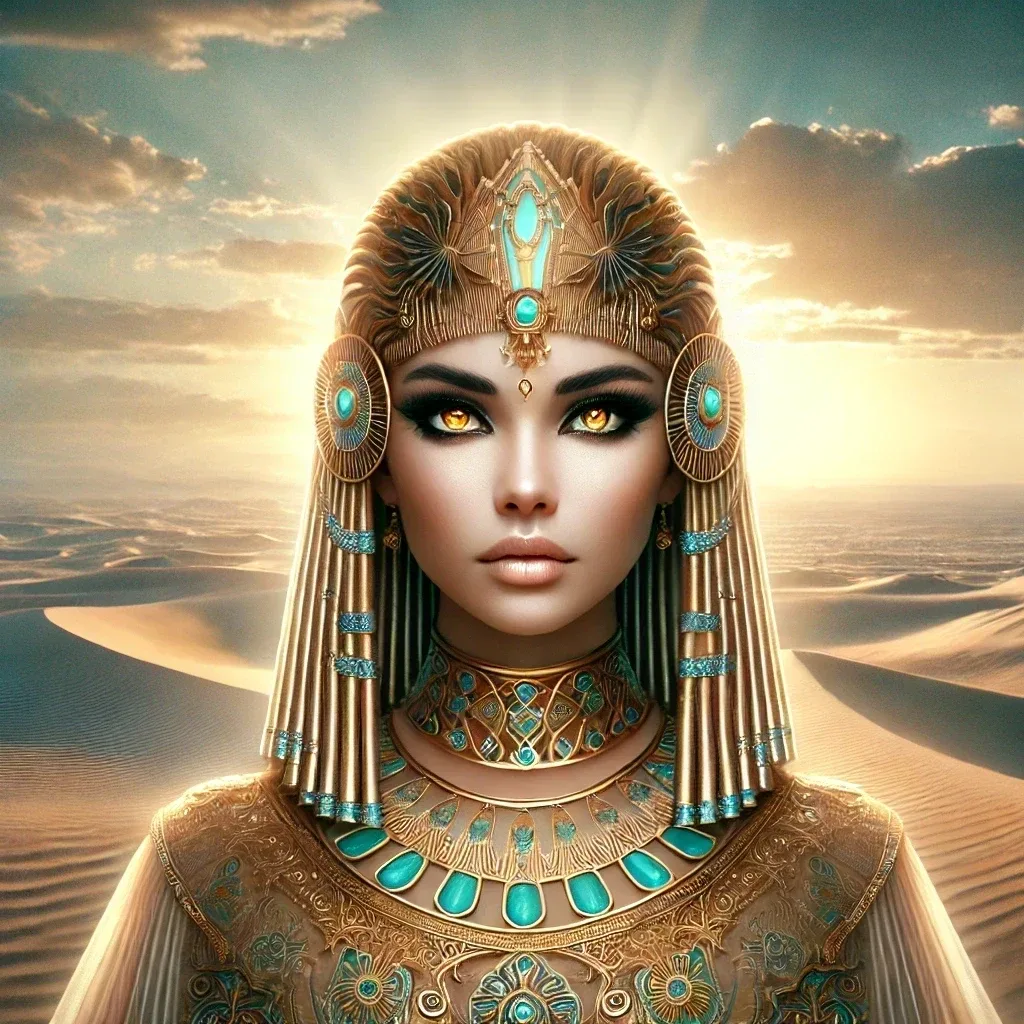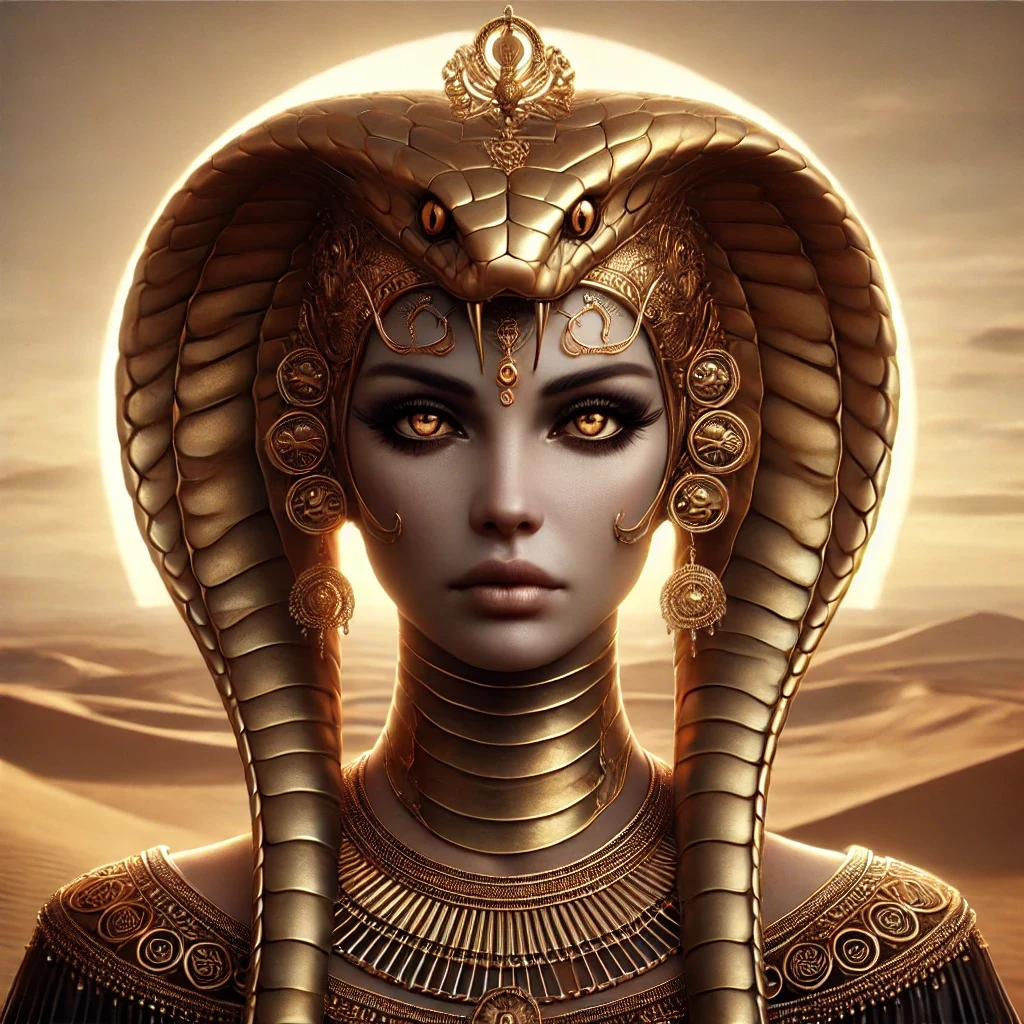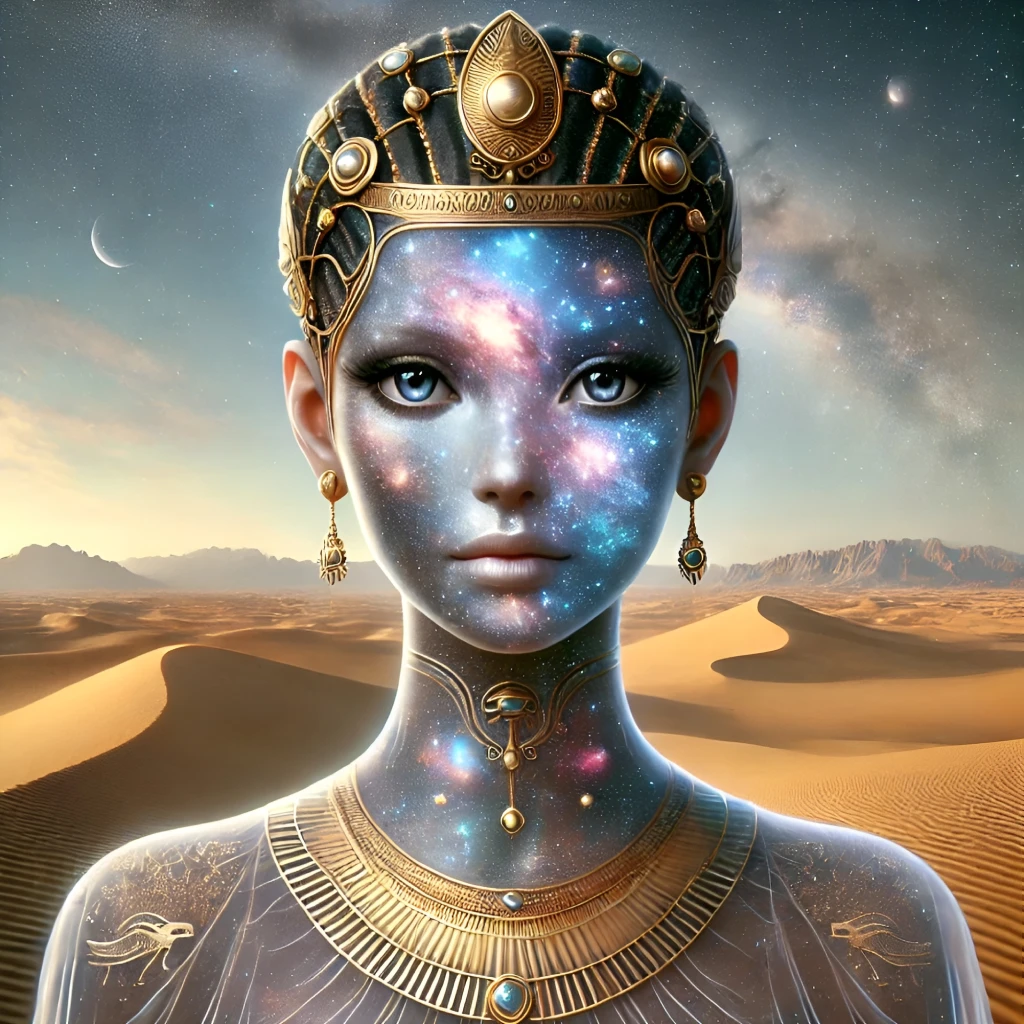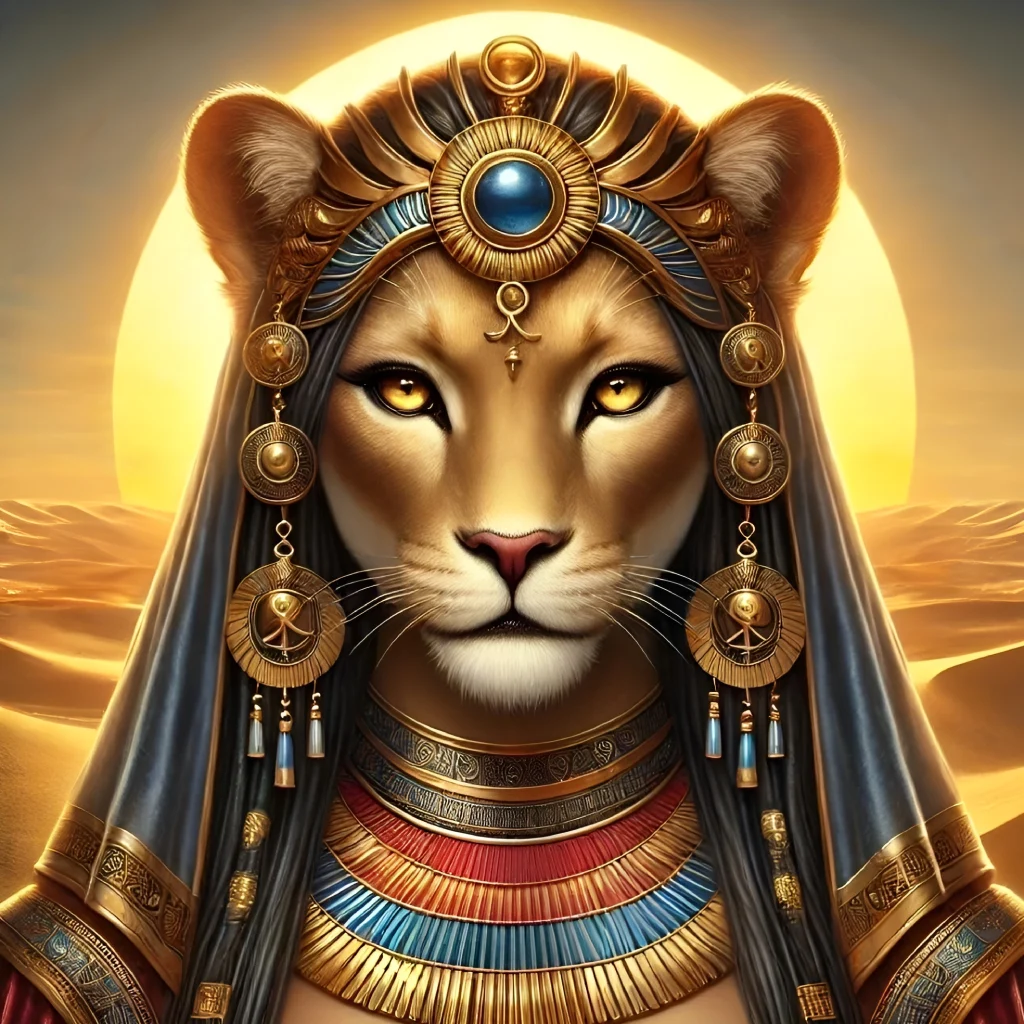In the pantheon of ancient Egyptian deities, few figures embody the duality of nurturing and destructive forces as vividly as the goddess associated with the Nile’s inundation. Known as Satis, her name derives from the Egyptian word sṯ, meaning “to pour” or “to shoot,” reflecting her role in the annual flooding of the Nile, which was both a life-giving and potentially destructive event. She was also referred to by epithets such as “She Who Shoots Arrows” and “Mistress of Elephantine,” the latter linking her to the southern frontier of Egypt. As a guardian of the Nile’s source and a protector of the pharaoh, her influence extended beyond the natural world into the realms of sovereignty and cosmic order.
Origins
The origins of Satis are deeply rooted in the geography and mythology of ancient Egypt. Her worship can be traced back to the early dynastic periods, with her prominence growing during the Old Kingdom. She was closely associated with the island of Elephantine, near modern-day Aswan, where the Nile’s first cataract was believed to mark the river’s sacred source.
Early Depictions and Regional Significance
In her earliest depictions, she was venerated as a local deity of Elephantine, a strategic location that served as a gateway to Nubia and the source of the Nile. Her role as a guardian of the southern border made her a symbol of protection and sovereignty. Over time, her influence expanded, and she became integrated into the broader Egyptian pantheon, often paired with Khnum, the ram-headed god of the Nile’s source, and Anuket, the goddess of the cataracts.
Connection to the Nile’s Inundation
The annual flooding of the Nile was the lifeblood of ancient Egyptian civilization, and Satis was intimately linked to this phenomenon. She was believed to release the waters that would nourish the fields, ensuring fertility and abundance. This connection to the inundation elevated her status, making her a central figure in rituals and prayers aimed at securing a bountiful harvest.
Appearance
The visual representation of this goddess evolved over time, reflecting her multifaceted roles and the artistic styles of different periods. She was often depicted as a woman wearing the white crown of Upper Egypt, adorned with antelope horns, symbolizing her connection to the southern regions and the wilderness.
Iconography and Attributes
Satis’s most distinctive attribute was the ankh, the symbol of life, which she often held in one hand, emphasizing her role as a giver of sustenance and vitality. In her other hand, she frequently carried a scepter or a bow and arrows, underscoring her dual nature as both a nurturing and a protective force. The arrows symbolized her ability to defend Egypt’s borders and repel chaos, while the scepter represented her authority and divine power.
Animal Associations
The antelope, particularly the gazelle, was sacred to her, reflecting her connection to the desert and the untamed aspects of nature. This animal was often depicted alongside her in art and hieroglyphs, serving as a symbol of agility, grace, and the wild forces she governed.
Abilities
As a deity of the Nile’s inundation, Satis’s powers were both life-giving and formidable. She was revered for her ability to control the waters that sustained Egypt, but she was also feared for her capacity to unleash destructive floods if angered.
Control Over Water
Her primary ability was her command over the Nile’s annual flood. She was believed to release the waters from their source, ensuring that the river would overflow its banks and deposit the rich silt that fertilized the fields. This power made her an essential figure in agricultural rituals and prayers for abundance.
Protective and Martial Aspects
In addition to her nurturing role, Satis was a fierce protector of Egypt’s borders. Her epithet “She Who Shoots Arrows” highlights her martial prowess, as she was thought to use her arrows to ward off enemies and chaotic forces. This aspect of her character made her a patroness of the pharaoh, who was seen as the earthly defender of Ma’at, or cosmic order.
Domain
Satis’s domain encompassed both the natural and the divine, bridging the earthly and the celestial. She was primarily associated with the Nile’s source and the southern frontier of Egypt, but her influence extended far beyond these geographical boundaries.
The Nile and Fertility
The Nile was the central artery of ancient Egyptian civilization, and her role in controlling its waters placed her at the heart of the people’s survival. She was invoked in rituals to ensure the river’s timely and beneficial flooding, which was crucial for agriculture and the economy.
Sovereignty and Protection
As a guardian of Egypt’s borders, Satis was also a symbol of national unity and strength. Her presence at Elephantine, a key military and trade outpost, reinforced her association with sovereignty and the protection of the realm.
Myths
While few myths have survived that focus exclusively on Satis, she appears in several important narratives that highlight her roles and relationships within the pantheon.
The Triad of Elephantine
She was often depicted as part of a divine triad with Khnum and Anuket. In this triad, she was seen as the consort of Khnum and the mother of Anuket, symbolizing the interconnectedness of the Nile’s source, its flow, and its life-giving inundation. This triad was central to the religious life of Elephantine, where they were worshipped as the guardians of the Nile.
The Myth of the Distant Goddess
In the myth of the Distant Goddess, which features various goddesses taking on the role of the Eye of Ra, Satis is sometimes identified as the deity who flees to Nubia and must be coaxed back to Egypt. This story underscores her connection to the southern regions and her role as a bringer of life and order.
Symbolism
Satis’s symbolism is rich and multifaceted, reflecting her diverse roles and attributes. She was associated with several objects, animals, and natural phenomena that encapsulated her essence.
The White Crown and Antelope Horns
The white crown of Upper Egypt, combined with antelope horns, symbolized her authority over the southern regions and her connection to the wilderness. This headdress also linked her to the pharaoh, who wore a similar crown as a symbol of sovereignty.
The Ankh and Scepter
The ankh, representing life, and the scepter, symbolizing power, were central to her iconography. These objects highlighted her dual role as a giver of life and a wielder of divine authority.
The Gazelle
The gazelle, sacred to her, represented agility, grace, and the untamed forces of nature. This animal was often depicted in art and hieroglyphs as a symbol of her connection to the desert and the wild.
Worship
Satis’s worship was deeply ingrained in the religious practices of ancient Egypt, particularly in the region of Elephantine. Temples, rituals, and festivals were dedicated to her, and her veneration evolved over time.
Temples and Priests
The temple of Satis at Elephantine was one of the most important religious sites in ancient Egypt. It served as a center for her worship and was closely associated with the Nile’s inundation. Priests of Satis played a crucial role in maintaining her cult and performing rituals to ensure the river’s beneficial flooding.
Rituals and Festivals
Rituals dedicated to her often involved offerings of water, flowers, and incense, symbolizing the life-giving properties of the Nile. Festivals in her honor were held during the inundation season, celebrating the river’s rise and the fertility it brought to the land.
Associations
Satis’s connections to other deities and figures within the Egyptian pantheon highlight her importance and the complexity of her character.
Khnum and Anuket
As part of the Elephantine triad, she was closely associated with Khnum, the god of the Nile’s source, and Anuket, the goddess of the cataracts. Together, they represented the interconnected forces that governed the Nile and its life-giving waters.
The Pharaoh
She was also closely linked to the pharaoh, who was seen as her earthly counterpart. The pharaoh’s role as the defender of Ma’at and the protector of Egypt’s borders mirrored her own attributes as a guardian and a bringer of order.
Legacy
The decline of Satis’s worship was tied to broader political and religious changes in ancient Egypt. However, her legacy endures in the cultural and historical memory of the Nile’s significance.
Decline and Transformation
With the rise of new religious movements and the decline of Elephantine as a political and religious center, her worship gradually diminished. However, elements of her character and symbolism were absorbed into the worship of other deities, such as Isis, who also embodied nurturing and protective qualities.
Modern Remembrance
Today, Satis is remembered as a symbol of the Nile’s life-giving power and the enduring connection between the natural world and the divine. Her legacy lives on in the archaeological remains of her temples and the stories that continue to inspire fascination with ancient Egypt.
Trivia
- The Arrow of Sovereignty: Her epithet “She Who Shoots Arrows” was not only symbolic of her protective role but also tied to the pharaoh’s authority. Arrows were sometimes ritually shot toward the four cardinal directions during coronation ceremonies to symbolize the ruler’s dominion over all of Egypt, a practice linked to her influence.
- The Star Connection: Some scholars suggest that her name may have been associated with the star Sirius, known as Sopdet in Egyptian. Sirius’s heliacal rising coincided with the Nile’s inundation, further connecting her to the cycles of nature and celestial phenomena.
- A Goddess of Purity: In addition to her role in the Nile’s flooding, she was also associated with ritual purification. Water from her sacred well at Elephantine was used in cleansing ceremonies, emphasizing her connection to both physical and spiritual purity.
- The Antelope Goddess: While the gazelle was her primary sacred animal, she was also linked to the oryx, another antelope species. The oryx’s ability to survive in arid environments mirrored her role as a guardian of the desert and the Nile’s life-giving waters.
- A Goddess of the Hunt: Beyond her protective and nurturing roles, she was occasionally depicted as a huntress, reflecting her connection to the wilderness and her ability to strike down chaos with precision.
- The Divine Nurse: In some texts, Satis is described as a wet nurse to the pharaoh, symbolizing her role in nurturing and sustaining the kingdom. This imagery reinforced her connection to fertility and the life-giving properties of the Nile.
- The Southern Sentinel: Her association with Elephantine made her a key figure in Egypt’s interactions with Nubia. She was often invoked in diplomatic and military contexts to ensure the protection of Egypt’s southern borders.
- A Goddess of Time: The annual inundation of the Nile was a marker of time for the ancient Egyptians, and her role in this cycle linked her to the concept of cyclical renewal and the passage of time.
- The Forgotten Temple: While her temple at Elephantine is well-known, lesser-known shrines dedicated to her existed as far north as Thebes. These smaller temples highlight her widespread veneration beyond her primary cult center.
- A Symbol of Unity: Satis’s white crown, representing Upper Egypt, and her association with the Nile’s source made her a unifying figure between the northern and southern regions of Egypt. She embodied the harmony and balance essential to the kingdom’s stability.



